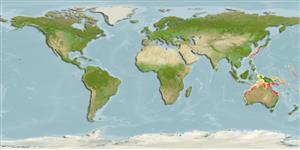>
Callionymiformes (Dragonets) >
Callionymidae (Dragonets)
Etymology: Callionymus: Greek, kallion, comparative of kallos = beautiful + Greek, onyma = name; with a better name.
More on author: Ogilby.
Environment: milieu / climate zone / depth range / distribution range
Écologie
marin; saumâtre démersal. Tropical
Western Pacific: northern Australia.
Taille / Poids / Âge
Maturity: Lm ? range ? - ? cm
Max length : 25.0 cm TL mâle / non sexé; (Ref. 7292)
Épines dorsales (Total) : 4; Rayons mous dorsaux (Total) : 9; Rayons mous anaux: 9. Lateral line distinct, first dorsal fin distinctly colored (Ref. 9002). Body brown above, closely speckled with darker spots of varying sizes, whitish below. First dorsal fin with a black spot on third spine. Filamentous spines with numerous grey annuli. Second dorsal fin, caudal fin, pectoral and pelvic fins with darker spots. Anal fin with a broad dusky margin. Occipital region without bony ridges or protuberances, but with numerous small granular rugosities. Males with a black spot on third spine of first dorsal fin (Ref 42832).
Found on coastal and sandy estuaries along seagrass and reef margins, usually in small aggregations (Ref. 9002).
Life cycle and mating behavior
Maturité | Reproduction | Frai | Œufs | Fécondité | Larves
Grant, E.M., 1986. Guide to fishes. Reprinted edition. The Department of Harbours and Marine. Brisbane, Queensland. 896 p. (Ref. 7292)
Statut dans la liste rouge de l'IUCN (Ref. 130435: Version 2024-2)
Menace pour l'homme
Harmless
Utilisations par l'homme
Outils
Articles particuliers
Télécharger en XML
Sources Internet
Estimates based on models
Preferred temperature (Ref.
123201): 23.3 - 28.6, mean 27.4 °C (based on 326 cells).
Phylogenetic diversity index (Ref.
82804): PD
50 = 0.5000 [Uniqueness, from 0.5 = low to 2.0 = high].
Bayesian length-weight: a=0.00891 (0.00410 - 0.01937), b=2.78 (2.60 - 2.96), in cm total length, based on LWR estimates for this Genus-body shape (Ref.
93245).
Niveau trophique (Ref.
69278): 3.4 ±0.4 se; based on size and trophs of closest relatives
Résilience (Ref.
120179): Milieu, temps minimum de doublement de population : 1,4 à 4,4 années (Preliminary K or Fecundity.).
Fishing Vulnerability (Ref.
59153): Low vulnerability (15 of 100).
